Josef A. Nossek
Decoupling Networks and Super-Quadratic Gains for RIS Systems with Mutual Coupling
Nov 26, 2024Abstract:We propose decoupling networks for the reconfigurable intelligent surface (RIS) array as a solution to benefit from the mutual coupling between the reflecting elements. In particular, we show that when incorporating these networks, the system model reduces to the same structure as if no mutual coupling is present. Hence, all algorithms and theoretical discussions neglecting mutual coupling can be directly applied when mutual coupling is present by utilizing our proposed decoupling networks. For example, by including decoupling networks, the channel gain maximization in RIS-aided single-input single-output (SISO) systems does not require an iterative algorithm but is given in closed form as opposed to using no decoupling network. In addition, this closed-form solution allows to analytically analyze scenarios under mutual coupling resulting in novel connections to the conventional transmit array gain. In particular, we show that super-quadratic (up to quartic) channel gains w.r.t. the number of RIS elements are possible and, therefore, the system with mutual coupling performs significantly better than the conventional uncoupled system in which only squared gains are possible. We consider diagonal as well as beyond diagonal (BD)-RISs and give various analytical and numerical results, including the inevitable losses at the RIS array. In addition, simulation results validate the superior performance of decoupling networks w.r.t. the channel gain compared to other state-of-the-art methods.
Non-Reciprocal Reconfigurable Intelligent Surfaces
Nov 23, 2024



Abstract:In contrast to conventional RIS, the scattering matrix of a non-reciprocal RIS (NR-RIS) is non-symmetric, leading to differences in the uplink and the downlink components of NR-RIS cascaded channels. In this paper, a physically-consistent device model is proposed in which an NR-RIS is composed of multiple groups of two-port elements inter-connected by non-reciprocal devices. The resulting non-reciprocal scattering matrix is derived for various cases including two-element groups connected with isolators or gyrators, and general three-element groups connected via circulators. Signal models are given for NR-RIS operating in either reflecting-only or simultaneously transmitting and reflecting modes. The problem of NR-RIS design for non-reciprocal beamsteering is formulated for three-element circulator implementations, and numerical results confirm that non-reciprocal beamsteering can be achieved with minimal sidelobe power. We also show that our physically consistent NR-RIS architecture is effective in implementing channel reciprocity attacks, achieving similar performance to that with idealized NR-RIS models.
Sum Rate Maximization in the Constant Envelope MIMO Downlink with the RZF Precoder
Nov 05, 2024
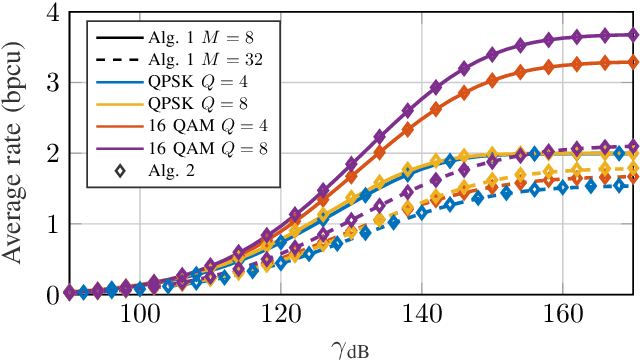
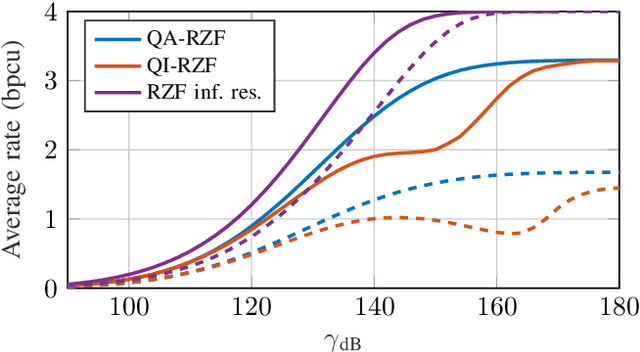
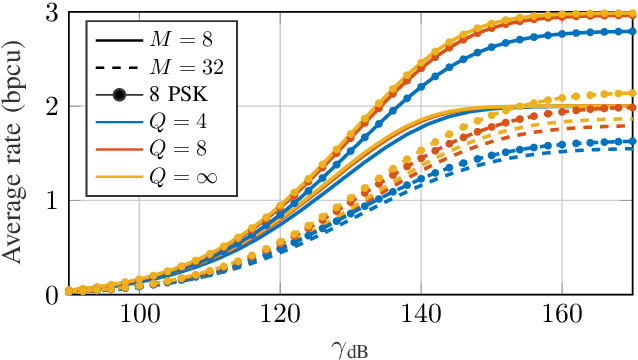
Abstract:Feeding power amplifiers (PAs) with constant envelope (CE) signals is an effective way to reduce the power consumption in massive multiple-input-multiple-output (MIMO) systems. The nonlinear distortion caused by CE signaling must be mitigated by means of signal processing to improve the achievable sum rates. To this purpose, many linear and nonlinear precoding techniques have been developed for the CE MIMO downlink. The vast majority of these CE precoding techniques do not include a power allocation scheme, which is indispensable to achieve adequate performances in the downlink with channel gain imbalances between users. In this paper, we present two algorithms to produce a power allocation scheme for regularized zero-forcing (RZF) precoding in CE MIMO downlink. Both techniques are based on transforming the CE quantized MIMO downlink to an approximately equivalent system of parallel single-input-single-output (SISO) channels. The first technique is proven to solve the sum rate maximization problem in the approximate system optimally, whereas the second technique obtains the local maximum with lower complexity. We also extend another state-of-the-art quantization aware sum rate maximization algorithm with linear precoding to the CE downlink. Numerical results illustrate significant gains for the performance of the RZF precoder when the CE quantization is taken into account in a power allocation. Another key numerical result is that the proposed RZF techniques achieve almost the identical performance so that the one with lower computational complexity is chosen as the main method. Results also show that the proposed RZF precoding schemes perform at least as good as the state-of-the-art method with an advantage that the main RZF method has significantly lower computational complexity than the state-of-the-art.
Performance Analysis of Systems with Coupled and Decoupled RISs
Feb 23, 2024



Abstract:We analyze and compare different methods for handling the mutual coupling in RIS-aided communication systems. A new mutual coupling aware algorithm is derived where the reactance of each element is updated successively with a closed-form solution. In comparison to existing element-wise methods, this approach leads to a considerably reduced computational complexity. Furthermore, we introduce decoupling networks for the RIS array as a potential solution for handling mutual coupling. With these networks, the system model reduces to the same structure as when no mutual coupling were present. Including decoupling networks, we can optimize the channel gain of a RIS-aided SISO system in closed-form which allows to analyze the scenario under mutual coupling analytically and to draw connections to the conventional transmit array gain. In particular, a super-quadratic channel gain can be achieved which scales as N^4 where N is the number of RIS elements.
Physically Consistent Modelling of Wireless Links with Reconfigurable Intelligent Surfaces Using Multiport Network Analysis
Aug 23, 2023Abstract:RISs are an emerging technology for engineering the channels of future wireless communication systems. The vast majority of research publications on RIS are focussing on system-level optimization and are based on very simplistic models ignoring basic physical laws. There are only a few publications with a focus on physical modeling. Nevertheless, the widely employed model is still inconsistent with basic physical laws. We will show that even with a very simple abstract model based on isotropic radiators, ignoring any mismatch, mutual coupling, and losses, each RIS element cannot be modeled to simply reflect the incident signal by manipulating its phase only and letting the amplitude unchanged. We will demonstrate the inconsistencies with the aid of very simple toy examples, even with only one or two RIS elements. Based on impedance parameters, the problems associated with scattering parameters can be identified enabling a correct interpretation of the derived solutions.
Compact Uniform Circular Quarter-Wavelength Monopole Antenna Arrays with Wideband Decoupling and Matching Networks
May 19, 2021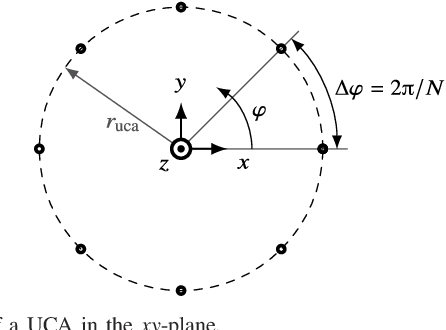
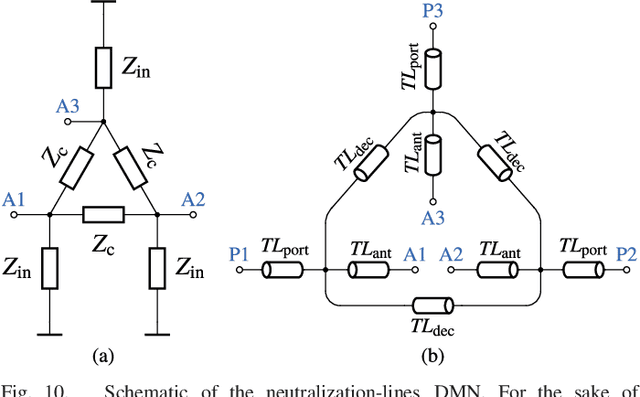
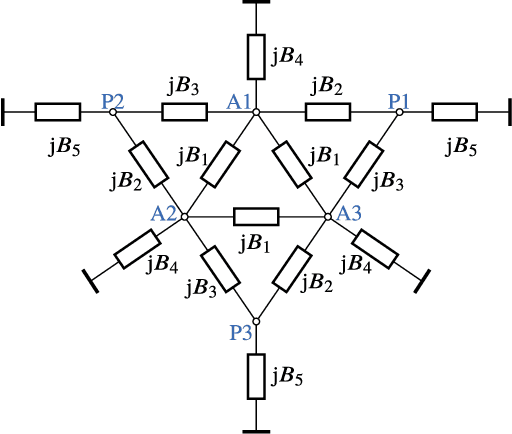
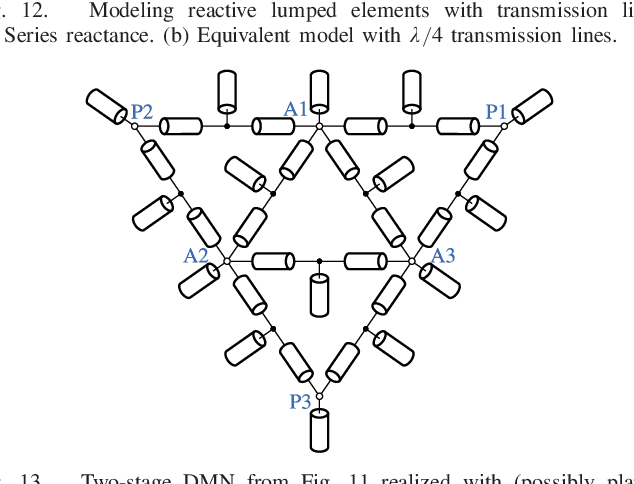
Abstract:Two novel decoupling and matching networks (DMNs) in microstrip technology for three-element uniform circular arrays (UCAs) are investigated and compared to a more conventional DMN approach with simple neutralization lines. The array elements are coaxially-fed quarter-wavelength monopole antennas over a finite groundplane. Three-element arrays are considered since UCAs with an odd number of elements are able to provide an almost constant maximum array factor over the whole azimuthal angular range. The new designs are explained from a theoretical point of view and their implementations are compared to four- and three-elements UCAs without DMN in terms of decoupling and matching bandwidth as well as beamforming capabilities. In addition to excellent decoupling and matching below -16 dB, a broader bandwidth is obtained by the two DMNs. The reasons for the enhanced bandwidth are similar in both cases: By introducing several circuit elements offering additional degrees of freedom, matching of the monopole input impedances at different frequencies becomes feasible. One of the presented designs offers a larger bandwidth, while the other design is able to provide a better total efficiency. Scattering parameters, radiation patterns, beamforming capabilities, and enhanced gain are all verified by measurements over the operating bandwidth.
* 15 pages, 28 figures, 1 table, published in IEEE Transactions on Antennas and Propagation
Sparse Linear Precoders for Mitigating Nonlinearities in Massive MIMO
May 11, 2021



Abstract:Dealing with nonlinear effects of the radio-frequency(RF) chain is a key issue in the realization of very large-scale multi-antenna (MIMO) systems. Achieving the remarkable gains possible with massive MIMO requires that the signal processing algorithms systematically take into account these effects. Here, we present a computationally efficient linear precoding method satisfying the requirements for low peak-to-average power ratio (PAPR) and low-resolution D/A-converters (DACs). The method is based on a sparse regularization of the precoding matrix and offers advantages in terms of precoded signal PAPR as well as processing complexity. Through simulation, we find that the method substantially improves conventional linear precoders.
 Add to Chrome
Add to Chrome Add to Firefox
Add to Firefox Add to Edge
Add to Edge